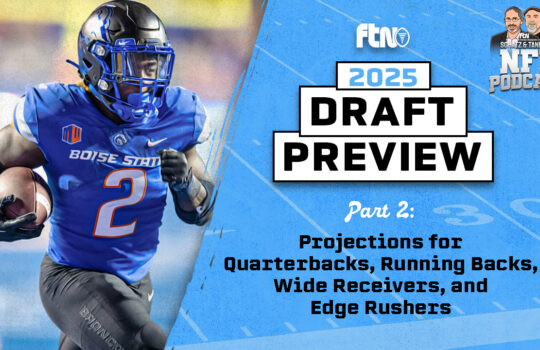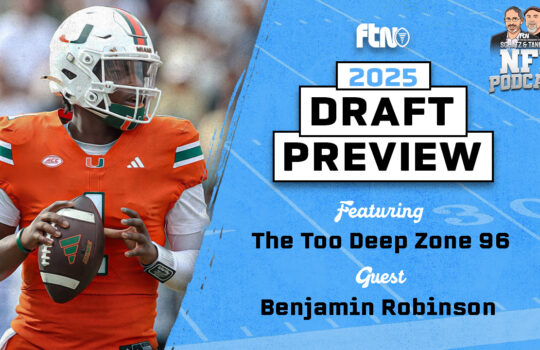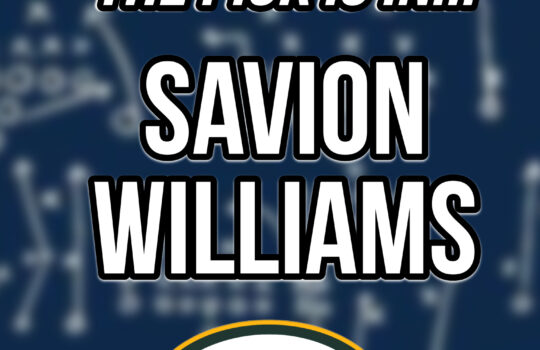
We’ve got a new No. 1 team atop the DVOA table this week, but it’s not the team you’re expecting. For most advanced EPA-based metrics across the Internet, the No. 1 team in the NFL is now the Buffalo Bills. DVOA has things a bit differently. Our new No. 1 team is the 9-5 Baltimore Ravens.
Baltimore knocks Detroit down to second place after the Lions lost to the Bills. Green Bay is a surprising third, followed by Buffalo, Philadelphia, and then Minnesota. Kansas City is up one spot to seventh, San Francisco down one spot to eighth.
The Ravens have been floating around with one of the best offensive DVOA ratings we’ve ever measured for most of the season. Their defense has now improved to the point where the whole team comes out at No. 1. So you might be wondering, what are the differences between DVOA and EPA that have the Ravens ahead of the Bills in our measurements? I was curious too, so I did some digging.
I’m going to use the EPA numbers from RBSDM.com and we’re going to look at VOA instead of DVOA to take out opponent adjustments. The Ravens and Bills have played similar schedules, both close to average, so that doesn’t make much of a difference. Note that I did this research before Monday Night Football so numbers may differ slightly from the numbers you see elsewhere on the website.
Ravens Offense vs. Bills Offense
The basics of this one are simple. VOA has the Ravens first (33.8%) followed by the Bills (25.5%) and then the Lions (16.7%). EPA per play puts the Bills first instead (.220) followed by the Ravens (.198) and then the Commanders (.152) with the Lions fourth (.142).
EPA likes the Bills running game more than the Ravens running game. The rank of rushing plays in EPA goes Eagles, Bills, Commanders, and then Ravens. The rank of rushing plays in VOA goes Ravens, Eagles, Lions, and then Bills. A big difference here regards fumbles. You may remember that a couple of years ago, I introduced a new version of DVOA that dialed down the penalty for turnovers because turnovers are less predictive than yards and first downs. The Baltimore Ravens have had six fumbles on running plays plus another five aborted plays which are counted as runs in the EPA calculations. The Buffalo Bills have had zero. That’s right, zero aborted plays and zero fumbles on running plays.
You can see the importance of the fumbles by taking them out of the EPA calculations. Remove turnovers, and now the Ravens are second in EPA per play on runs, ahead of the Bills.
Another major issue regards fourth downs and how important they are. The Bills have been the best team in the league on fourth down this year, by a lot. That’s good in VOA, but it’s really good in EPA, because the difference in expected points between converting and not converting fourth down is huge. The Bills’ top three fourth-down conversions rank 1, 4, and 9 in terms of their value in EPA this year. Those same plays rank 6, 9, and 17 in terms of their value in VOA. This brings up an important question about descriptive vs. predictive statistics. Is Buffalo’s success on fourth downs indicitive that they will have more success in the future? There’s a strong argument that this is a small sample of plays with outsized importance in EPA and not necessarily predictive of future success. There’s also a strong argument that just going for it — which the Bills do more often than the Ravens — is indicitive of future success because the Bills are making smarter decisions on fourth downs. Either way, fourth downs are a big reason for the difference between VOA and EPA on offense.
A couple of smaller issues that also seem to be part of the difference:
1) The Ravens are getting more credit for their first-down runs in VOA. VOA has the Ravens first on these plays with the Bills third. EPA has the Bills second and the Ravens fifth.
2) There may be an issue with how much EPA changes in the fourth quarter. If we look at runs in the fourth quarter, the Bills rank 17th in EPA but 27th in VOA. If we look at passes in the fourth quarter, the Bills are first in EPA with the Ravens second, but they are tied in VOA.
3) Penalties are an issue. VOA is counting only certain penalties, where Buffalo has more penalties than Baltimore. EPA is counting all penalties, where Baltimore has more penalties than Buffalo. That’s another place where we can have a good debate about which penalties are and are not predictive.
Ravens Defense vs. Bills Defense
Right now, the Bills rank 10th in defensive VOA (-4.7%) while the Ravens have improved to 11th (-2.7%). There’s a much larger gap in EPA per play where the Bills rank 14th (.004) and the Ravens rank 21st (.035). Just like with VOA and DVOA, EPA per play is better on defense when it is lower.
Just as with the offensive side of the ball, turnovers are part of the issue here because they just have more importance in EPA than they do in VOA. The Bills have 13 interceptions and 15 forced fumbles on defense. The Ravens have only eight interceptions and 10 forced fumbles on defense. The length of turnover returns also matters. VOA treats all turnover returns the same, based on the idea that the ability of an offense to tackle a defensive player after a return doesn’t really tell us anything about how well that offense plays offense. The Bills have two pick-sixes this year. The Ravens do not have any, and they have only one interception return for than a yard (this week against the Giants).
If you exclude plays with turnovers from defensive EPA per play, the Ravens improve to 15th and the Bills drop all the way to 27th!
Otherwise, the difference appears to be entirely about passing plays. Against the run, VOA has the Ravens third and the Bills sixth while EPA has the Ravens third and the Bills seventh. The Ravens have been very solid against the run this season.
Against the pass, including scrambles, VOA has the Bills 11th and the Ravens 17th. EPA has the Bills 18th and the Ravens all the way down at 30th.
On offense, I noted that the Ravens were getting more credit for first-down runs in VOA. Well on defense, the Ravens are getting more credit against first-down passes instead. On first-down passes, VOA has the Bills third and the Ravens 20th. EPA instead has the Bills sixth and the Ravens 27th. The ranks are more similar between the two stats on second-down and third-down passes.
Once again, it seems important that fourth downs have an outsized impact on EPA. The Bills have been much better than the Ravens on defense for fourth downs this season. And once again, the fourth quarter and changes in EPA based on the score and time left are an issue. In the fourth quarter, VOA has the Ravens defense ranked 14th while EPA has the Ravens ranked 30th. This could be a difference in how we treat plays without much clock left at the end of the game.
Hopefully, walking through this was interetsing for the readers! The big issues seem to be turnovers and fourth downs. VOA is based on the idea that these plays simply aren’t as predictive as EPA shows. The other issue might be the fourth quarter, and differences between how the two metrics treat those plays.
Full DVOA Table Through Week 15
These are the FTN DVOA ratings through 15 weeks of 2024. Our Defense-adjusted Value Over Average (DVOA) system breaks down every single play and compares a team’s performance to the league average based on situation in order to determine value over average. (Explained further here.)
OFFENSE and DEFENSE DVOA are adjusted for performance indoors and consider all fumbles, kept or lost, as equal value. SPECIAL TEAMS DVOA is adjusted for type of stadium (warm, cold, dome, Denver) and week of season. As always, positive numbers represent more points so DEFENSE is better when it is NEGATIVE. WEIGHTED DVOA represents an attempt to figure out how a team is playing right now, as opposed to over the season as a whole, by making recent games more important than earlier games.
| RK | TEAM | TOTAL DVOA |
LAST WEEK |
WEI. DVOA |
RK | W-L | OFF. DVOA |
OFF. RK |
DEF. DVOA |
DEF. RK |
S.T. DVOA |
S.T. RK |
|---|---|---|---|---|---|---|---|---|---|---|---|---|
| 1 | BAL | 37.7% | 2 | 40.1% | 1 | 9-5 | 34.8% | 1 | -3.8% | 13 | -0.9% | 22 |
| 2 | DET | 35.4% | 1 | 34.2% | 2 | 12-2 | 18.1% | 4 | -11.8% | 5 | 5.5% | 2 |
| 3 | GB | 28.2% | 3 | 31.5% | 3 | 10-4 | 20.7% | 3 | -6.7% | 8 | 0.8% | 14 |
| 4 | BUF | 27.0% | 4 | 27.5% | 5 | 11-3 | 26.5% | 2 | -4.8% | 10 | -4.2% | 29 |
| 5 | PHI | 25.1% | 5 | 31.4% | 4 | 12-2 | 9.2% | 9 | -15.1% | 3 | 0.9% | 12 |
| 6 | MIN | 21.3% | 6 | 17.0% | 6 | 12-2 | 5.2% | 13 | -17.1% | 2 | -1.0% | 23 |
| 7 | KC | 15.2% | 8 | 9.9% | 10 | 13-1 | 8.9% | 10 | -4.4% | 11 | 1.9% | 9 |
| 8 | SF | 12.6% | 7 | 9.7% | 11 | 6-8 | 8.2% | 11 | -8.9% | 6 | -4.4% | 30 |
| 9 | HOU | 11.4% | 11 | 9.2% | 12 | 9-5 | -10.5% | 24 | -19.3% | 1 | 2.6% | 6 |
| 10 | DEN | 10.9% | 10 | 13.0% | 7 | 9-5 | -7.3% | 21 | -13.6% | 4 | 4.6% | 4 |
| 11 | PIT | 10.5% | 12 | 10.4% | 8 | 10-4 | -2.1% | 17 | -6.8% | 7 | 5.8% | 1 |
| 12 | WAS | 9.4% | 14 | 9.2% | 13 | 9-5 | 13.7% | 6 | 6.0% | 25 | 1.7% | 10 |
| 13 | LAC | 9.0% | 9 | 10.4% | 9 | 8-6 | 3.0% | 15 | -5.5% | 9 | 0.5% | 15 |
| 14 | TB | 8.4% | 16 | 7.0% | 16 | 8-6 | 11.7% | 7 | 1.7% | 17 | -1.6% | 25 |
| 15 | ARI | 8.3% | 13 | 9.0% | 14 | 7-7 | 7.7% | 12 | -1.0% | 15 | -0.4% | 19 |
| 16 | LAR | 5.2% | 17 | 8.7% | 15 | 8-6 | 10.3% | 8 | 2.7% | 18 | -2.4% | 26 |
| RK | TEAM | TOTAL DVOA |
LAST WEEK |
WEI. DVOA |
RK | W-L | OFF. DVOA |
OFF. RK |
DEF. DVOA |
DEF. RK |
S.T. DVOA |
S.T. RK |
| 17 | CIN | 2.1% | 18 | 2.4% | 17 | 6-8 | 13.8% | 5 | 10.4% | 29 | -1.3% | 24 |
| 18 | SEA | -0.8% | 15 | -6.2% | 19 | 8-6 | -6.0% | 20 | -4.3% | 11 | 0.8% | 13 |
| 19 | NO | -6.3% | 20 | -11.3% | 22 | 5-9 | -4.6% | 19 | 4.0% | 20 | 2.4% | 7 |
| 20 | ATL | -6.9% | 19 | -13.0% | 24 | 7-7 | 3.5% | 14 | 6.8% | 26 | -3.6% | 28 |
| 21 | IND | -7.9% | 21 | -9.6% | 20 | 6-8 | -9.4% | 22 | -0.3% | 16 | 1.2% | 11 |
| 22 | NYJ | -12.3% | 22 | -11.2% | 21 | 4-10 | -4.3% | 18 | 7.4% | 28 | -0.7% | 20 |
| 23 | DAL | -12.8% | 26 | -12.4% | 23 | 6-8 | -12.2% | 26 | 5.6% | 24 | 4.9% | 3 |
| 24 | MIA | -12.9% | 23 | -5.3% | 18 | 6-8 | -9.9% | 23 | 3.1% | 19 | 0.1% | 17 |
| 25 | CHI | -13.8% | 24 | -15.1% | 26 | 4-10 | -10.8% | 25 | 5.0% | 23 | 2.0% | 8 |
| 26 | JAX | -15.3% | 25 | -14.0% | 25 | 3-11 | -0.8% | 16 | 18.2% | 32 | 3.8% | 5 |
| 27 | NYG | -23.1% | 27 | -25.2% | 28 | 2-12 | -12.3% | 27 | 7.3% | 27 | -3.5% | 27 |
| 28 | LV | -24.0% | 28 | -22.2% | 27 | 2-12 | -19.1% | 29 | 4.6% | 22 | -0.4% | 18 |
| 29 | TEN | -30.8% | 29 | -31.4% | 29 | 3-11 | -22.9% | 31 | -2.2% | 14 | -10.0% | 32 |
| 30 | NE | -36.1% | 31 | -36.1% | 32 | 3-11 | -19.2% | 30 | 17.1% | 30 | 0.2% | 16 |
| 31 | CLE | -36.1% | 32 | -32.7% | 31 | 3-11 | -27.3% | 32 | 4.3% | 21 | -4.5% | 31 |
| 32 | CAR | -37.2% | 30 | -32.2% | 30 | 3-11 | -18.8% | 28 | 17.7% | 31 | -0.7% | 21 |


















































 New York Jets
New York Jets  New England Patriots
New England Patriots  Miami Dolphins
Miami Dolphins  Buffalo Bills
Buffalo Bills  Pittsburgh Steelers
Pittsburgh Steelers  Cleveland Browns
Cleveland Browns  Cincinnati Bengals
Cincinnati Bengals  Baltimore Ravens
Baltimore Ravens  Tennessee Titans
Tennessee Titans  Jacksonville Jaguars
Jacksonville Jaguars  Indianapolis Colts
Indianapolis Colts  Houston Texans
Houston Texans  Las Vegas Raiders
Las Vegas Raiders  Los Angeles Chargers
Los Angeles Chargers  Kansas City Chiefs
Kansas City Chiefs  Denver Broncos
Denver Broncos  Washington Commanders
Washington Commanders  Philadelphia Eagles
Philadelphia Eagles  New York Giants
New York Giants  Dallas Cowboys
Dallas Cowboys  Minnesota Vikings
Minnesota Vikings  Green Bay Packers
Green Bay Packers  Detroit Lions
Detroit Lions  Chicago Bears
Chicago Bears  Tampa Bay Buccaneers
Tampa Bay Buccaneers  New Orleans Saints
New Orleans Saints  Carolina Panthers
Carolina Panthers  Atlanta Falcons
Atlanta Falcons  San Francisco 49ers
San Francisco 49ers  Seattle Seahawks
Seattle Seahawks  Los Angeles Rams
Los Angeles Rams  Arizona Cardinals
Arizona Cardinals 








 Boston Celtics
Boston Celtics  Brooklyn Nets
Brooklyn Nets  Philadelphia 76ers
Philadelphia 76ers  New York Knicks
New York Knicks  Toronto Raptors
Toronto Raptors  Chicago Bulls
Chicago Bulls  Detroit Pistons
Detroit Pistons  Milwaukee Bucks
Milwaukee Bucks  Cleveland Cavaliers
Cleveland Cavaliers  Indiana Pacers
Indiana Pacers  Orlando Magic
Orlando Magic  Atlanta Hawks
Atlanta Hawks  Charlotte Hornets
Charlotte Hornets  Miami Heat
Miami Heat  Washington Wizards
Washington Wizards  Denver Nuggets
Denver Nuggets  Minnesota Timberwolves
Minnesota Timberwolves  Oklahoma City Thunder
Oklahoma City Thunder  Portland Trail Blazers
Portland Trail Blazers  Utah Jazz
Utah Jazz  LA Clippers
LA Clippers  Golden State Warriors
Golden State Warriors  Los Angeles Lakers
Los Angeles Lakers  Phoenix Suns
Phoenix Suns  Sacramento Kings
Sacramento Kings  Dallas Mavericks
Dallas Mavericks  Houston Rockets
Houston Rockets  Memphis Grizzlies
Memphis Grizzlies  New Orleans Pelicans
New Orleans Pelicans  San Antonio Spurs
San Antonio Spurs 









